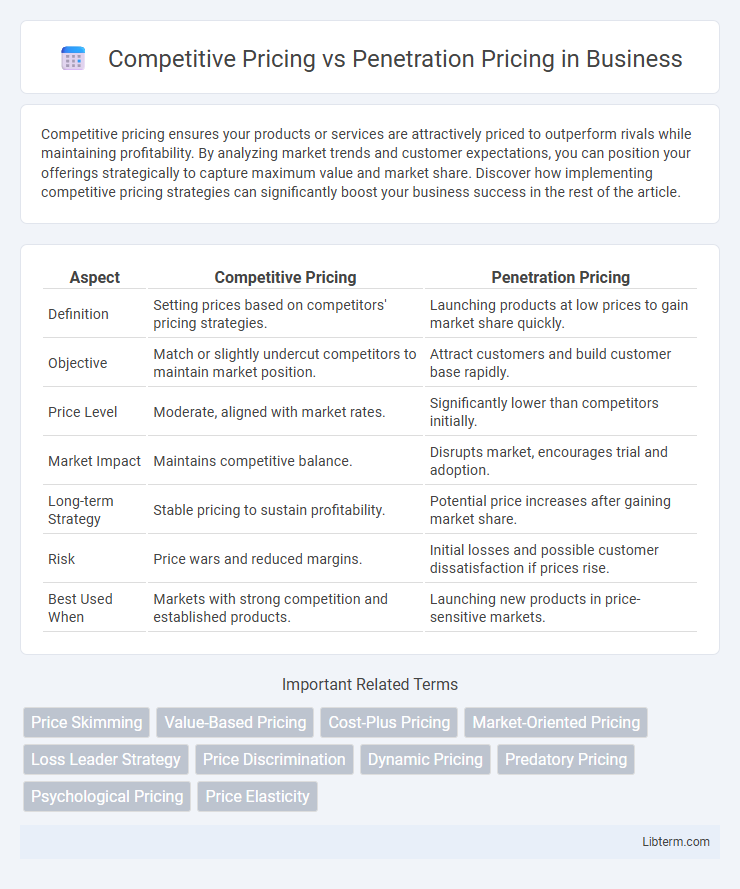Competitive pricing ensures your products or services are attractively priced to outperform rivals while maintaining profitability. By analyzing market trends and customer expectations, you can position your offerings strategically to capture maximum value and market share. Discover how implementing competitive pricing strategies can significantly boost your business success in the rest of the article.
Table of Comparison
| Aspect | Competitive Pricing | Penetration Pricing |
|---|---|---|
| Definition | Setting prices based on competitors' pricing strategies. | Launching products at low prices to gain market share quickly. |
| Objective | Match or slightly undercut competitors to maintain market position. | Attract customers and build customer base rapidly. |
| Price Level | Moderate, aligned with market rates. | Significantly lower than competitors initially. |
| Market Impact | Maintains competitive balance. | Disrupts market, encourages trial and adoption. |
| Long-term Strategy | Stable pricing to sustain profitability. | Potential price increases after gaining market share. |
| Risk | Price wars and reduced margins. | Initial losses and possible customer dissatisfaction if prices rise. |
| Best Used When | Markets with strong competition and established products. | Launching new products in price-sensitive markets. |
Understanding Competitive Pricing
Competitive pricing involves setting prices based on competitors' strategies, market demand, and comparable product value to attract price-sensitive customers while maintaining profitability. This pricing model requires continuous market analysis to ensure prices remain attractive yet sustainable, often using competitor benchmarks as primary reference points. Understanding competitive pricing empowers businesses to position themselves effectively in saturated markets and respond dynamically to price changes within the industry.
Defining Penetration Pricing
Penetration pricing is a strategy where a company sets a low initial price to quickly attract customers and capture market share in a competitive environment. This approach contrasts with competitive pricing, which involves setting prices based on competitors' pricing levels to maintain market position. Penetration pricing emphasizes rapid growth and customer base expansion by offering significant value at a lower cost.
Key Differences Between Competitive and Penetration Pricing
Competitive pricing sets product prices based on current market rates and competitor prices, aiming to match or slightly undercut rivals without drastically lowering profit margins. Penetration pricing involves introducing a product at a significantly low price to quickly gain market share and attract customers away from established competitors. The key difference lies in competitive pricing maintaining price levels aligned with the market, while penetration pricing strategically sacrifices short-term profits for rapid customer acquisition and market entry.
Advantages of Competitive Pricing
Competitive pricing offers the advantage of aligning product prices with market standards, ensuring that businesses remain attractive to price-sensitive consumers without sacrificing potential profit margins. This strategy facilitates quicker response to market changes and competitor pricing moves, maintaining steady sales volume and market share. Maintaining pricing parity also helps reinforce brand positioning and customer trust by avoiding price wars and perceived value dilution.
Benefits of Penetration Pricing Strategy
Penetration pricing strategy offers significant benefits including rapid market entry by attracting price-sensitive customers and quickly gaining market share. It helps establish brand presence and customer loyalty before competitors can react, reducing the risk of aggressive competition. Additionally, penetration pricing can lead to economies of scale, lowering production costs as demand increases over time.
Situations Best Suited for Competitive Pricing
Competitive pricing is best suited for mature markets with multiple established competitors offering similar products or services, where maintaining market share is a priority. Businesses leverage competitive pricing when price sensitivity is high among consumers, enabling them to attract price-conscious customers without initiating a price war. This strategy works well in industries like retail electronics or consumer goods, where product differentiation is minimal and consumers frequently compare prices before purchasing.
When to Use Penetration Pricing
Penetration pricing is most effective when entering a new market with the goal of quickly gaining market share and attracting price-sensitive customers. This strategy works best in industries with high competition and low switching costs, where setting lower initial prices can create strong customer loyalty and brand awareness. It is ideal for products with scalable production, allowing businesses to compensate for lower margins through increased sales volume.
Risks and Challenges of Each Strategy
Competitive pricing risks include potential price wars that erode profit margins and difficulty maintaining long-term sustainability against low-cost competitors. Penetration pricing challenges involve initial financial losses due to setting prices below cost and the risk of customers associating low prices with inferior quality. Both strategies require careful market analysis to balance growth objectives with profitability and brand positioning.
Impact on Market Share and Brand Positioning
Competitive pricing leverages pricing strategies aligned with existing market rates to maintain steady market share and reinforce a brand's established position, allowing companies to compete effectively without triggering price wars. Penetration pricing, characterized by initially lower prices to attract customers, rapidly increases market share by encouraging trial and adoption but risks compromising brand perception as a low-cost option. The choice between these strategies directly influences consumer perceptions, long-term brand equity, and the company's ability to sustain growth in competitive markets.
Choosing the Right Pricing Strategy for Your Business
Selecting the right pricing strategy depends on your business goals and market conditions. Competitive pricing sets prices based on rivals, helping maintain market share in mature markets, while penetration pricing sets low initial prices to attract customers quickly and build market presence. Evaluate product lifecycle, customer price sensitivity, and long-term profitability when deciding between these strategies to maximize growth and revenue.
Competitive Pricing Infographic

 libterm.com
libterm.com